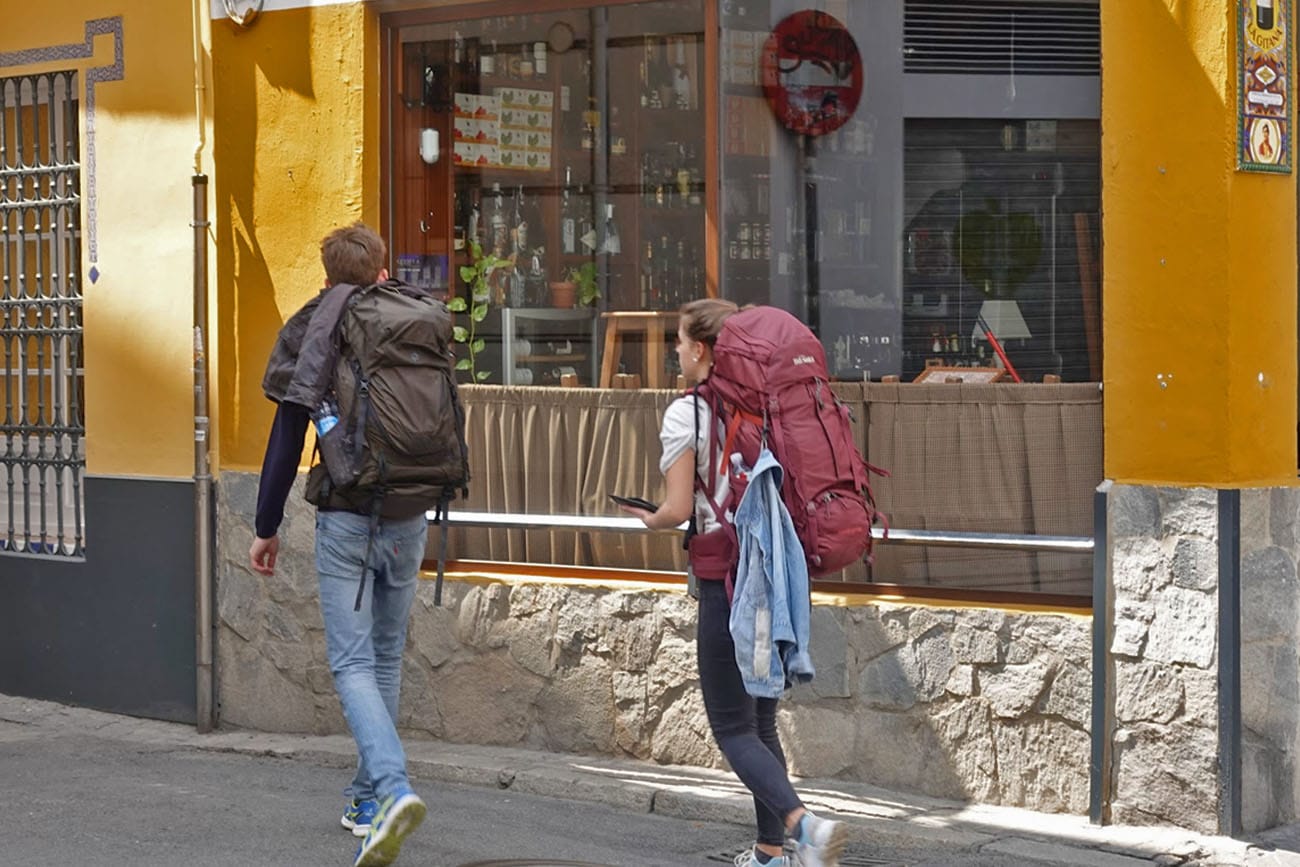
I wrote this backpacking Europe packing list because packing for travel can often be very difficult, especially for beginners.
Many first-time travelers make the mistake of packing way too much, so traveling from place to place becomes difficult. Overpacking can also make you a bigger target for thieves because it’s harder to keep track of your belongings.
This packing guide for Europe will help you determine the type of clothes and gear to bring, as well as provide tips for packing light.
Hey Ladies! Check out our new Backpacking Europe Packing List for Women where I cover women-specific packing suggestions.
This Europe Packing List Includes:
- Quick Tips for Packing Light
- Travel Clothing For Europe
- Travel Accessories and Travel Backpacks For Europe
- Travel Toiletries For Europe
- Travel Electronics for Europe
- What Not to Bring To Europe
- Where to Buy Travel Gear
Quick Tips For Packing Light While Backpacking Europe
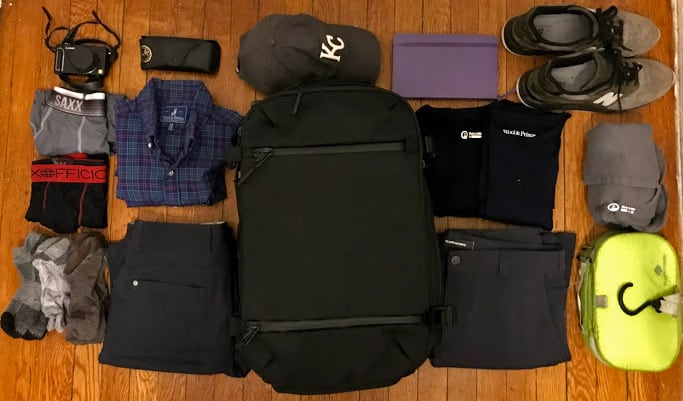
First, I suggest limiting yourself to 20-22 lbs worth of gear (including your backpack).
If you exceed 22 lbs (10kg), you run the risk of exceeding the carry-on weight limit for budget airlines. Even if weight limits aren’t an issue, I still suggest keeping your weight around 20 lbs for the sake of your back.
Quick Note About Looking Fashionable: I understand that packing light and being fashionable isn’t easy. I’ve written a guide on how to avoid looking like a tourist in Europe to help you dress well while traveling.
Cut The Clothing
Clothing is heavy, so cutting clothes is the easiest way to cut weight. There isn’t much difference between packing for two weeks or two months because you can do a load of laundry when needed.
- Ensure all your shirts and pants pair well with each other for maximum versatility. Choose dark and neutral colors because they hide dirt/stains better than light colors.
- I prefer dressing in layers if it’s cold. A big bulky coat isn’t practical unless you’re going somewhere extremely cold. A thermal base layer, long-sleeve t-shirt, sweater, and fleece jacket combo is more practical than a big coat. You can always add/subtract layers if needed. Click here for the Savvy Backpacker guide to keeping warm in the winter.
Cut the Toiletries
Liquids, gels, and creams are heavy, so packing full-sized bottles of shampoo, body wash, and other personal care items can quickly add multiple pounds to your bag.
I suggest limiting yourself to the basics or using travel-sized items. And remember, you can always buy things as you go.
Cut The Shoes
Many travelers pack multiple pairs of footwear, but I suggest limiting yourself to two pairs if packing light is your goal.
Clothing Packing List For Backpacking Europe

Let’s start with clothing since clothes make up a bulk of what’s in your bag.
Check out my guide to fashion in Europe for a more in-depth guide on being fashionable while traveling in Europe.
Travel Socks (5-8 Pairs)
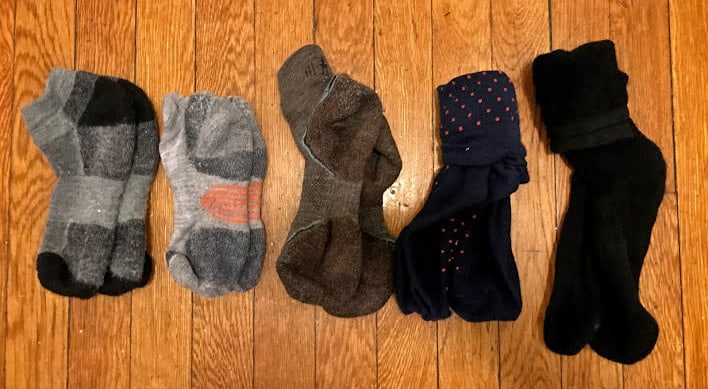
I never skimp on socks when I travel, and any experienced traveler will tell you the same thing.
I highly recommend spending extra money on quality socks, as they’ll help keep your feet dry, odor-free, and blister-free. Unfortunately, nice socks can be expensive but they’re 100% worth it.
Experienced travelers swear by high-quality, lightweight merino wool socks for the summer because merino wool naturally keeps your feet cool and dry (heavier-weight socks are better for winter travel).
I overpack when it comes to socks so I’ll bring 6-7 pairs because I like the feeling of wearing a fresh pair every day.
Characteristics Of Quality Socks:
- Moisture-Wicking: Feet sweat a ton when you spend hours walking. Merino wool naturally wicks that moisture away from your feet—which assists in eliminating odor and blisters.
- Fast-Drying: Quick-drying materials can be washed in your sink and they’ll dry in a few hours.
- Odor-Blocking: Quite a few socks have anti-bacterial properties and merino wool does this naturally—even in the summer.
- Cotton Is Bad: Cotton naturally absorbs moisture and holds it close to your skin—which leads to blisters and foul odors.
A quality pair of socks can be worn twice before they start to stink (although you’ll want to rotate the days you wear each pair).
TIP: Switch your socks halfway through the day to keep your feet extra happy.
Recommended Sock Brands:
- Bombas Socks: I’m a huge fan of my Bombas Merino wool socks—I wear them nearly every day (I own 10+ pairs). They have a great warranty and they’re well-made.
- SmartWool Socks: SmartWool socks were my first “nice” socks and I’m still a fan.
- Darn Tough Socks: Made in Vermont, this brand of really nice socks will last for years.
Looking for more? Check out our article about our favorite socks for travel.
Underwear (5-9 pairs)
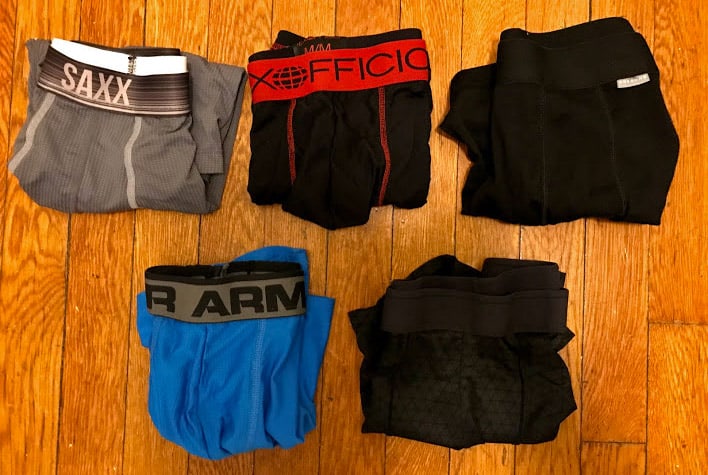
I typically pack around five to seven pairs of underwear but I might pack a few extras since they don’t add much bulk.
I prefer underwear that is made from synthetic materials because they’re designed to be quick-drying, breathable, and odor-resistant.
Here are some favorites:
- ExOfficio (Synthetic): ExOfficio is the #1 brand of travel underwear—they essentially invented the category. Available on Amazon.
- Under Armour (Synthetic): I am a fan of Under Armour underwear for travel and they’re pretty affordable when they’re on sale. Available on Amazon.
- Wool & Prince (Merino/Synthetic Blend): Wool & Prince is a small, independent clothing company that produces high-quality merino wool shirts and underwear (they are pricy, though). Their Boxer Briefs 2.0 (made of 78% merino wool, 22% nylon) are well-loved by the ultralight travel community — myself included. Available at Wool & Prince.
- Wooly (Merino): When it comes to 100% merino wool underwear, Wooly is one of the most affordable brands but there are some reports of holes developing after a few months. Available on Amazon
For a more in-depth article about travel underwear, check out our favorite travel underwear!
Shoes for Traveling Europe
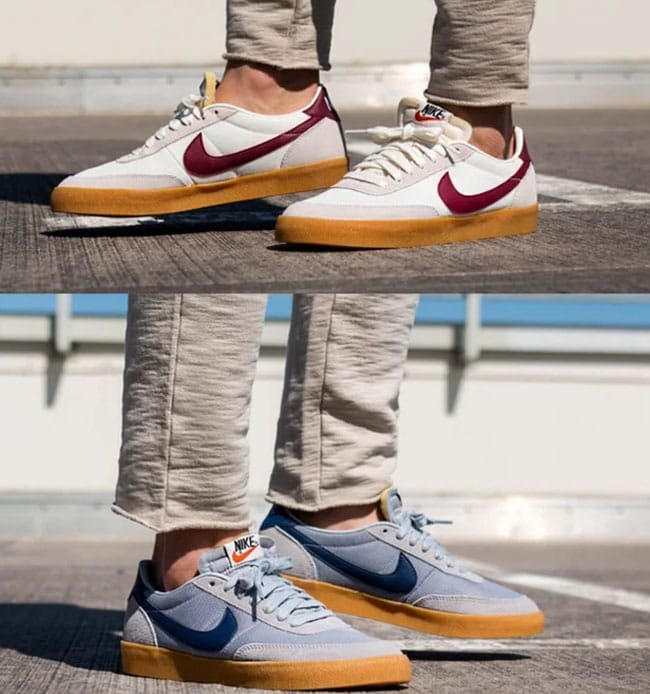
I normally recommend only packing one pair of shoes if you’re traveling light but it is understandable if you want to bring two pairs. Check out my favorite travel shoes for specific recommendations.
You’ll be on your feet for hours at a time while in Europe so you really want a sturdy pair of comfortable shoes for sightseeing.
These days, I opt for supportive and stylish New Balance sneakers (something from their 900 series). However, I also appreciate leather sneakers that are comfortable during the day and look stylish enough for a night out. Nike, New Balance, Adidas, and similar companies all make leather sneakers like this.
Some people opt for sturdier “hiking” shoes, as they’re usually waterproof and feature an all-terrain sole. They’re not super stylish, but they are usually pretty comfortable. If you plan on traveling during a rainy time of year, I would suggest this option. On that note, I suggest leaving the hiking boots at home unless you plan on doing some hardcore winter hiking.
Don’t forget a cheap pair of rubber flip-flop sandals if you’re going to stay in a hostel. You’ll want them for the showers. Trust me.
I highly recommend leaving your dress shoes at home. While sneakers would probably prevent you from entering any super swanky nightclubs, I doubt most budget backpackers can afford the cover charge + drink prices at those places. And a smart pair of sneakers will get you into most places.
For a more in-depth guide to finding the best shoes, check out our guide to fashionable and comfortable travel shoes.
Shirts and Tops


Casual Button-Up Shirts (2-4)
Casual, long-sleeve button-up shirts are a staple of my travel wardrobe because the sleeves can be rolled up for a casual look or kept long when needed. If you’re traveling in the middle of summer, a short-sleeve button-up is also a great option.
Things to consider when picking travel shirts:
- Versatile: Fancy dress shirts are overkill but a nice casual button-up works well day and night.
- Easy to wash: Stay away from things that you can’t easily wash or that are high maintenance.
- Dark colors: Dark colors (and patterns) do a better job of hiding stains.
Shirt Brands I Like:
- Bluffworks has a few high-performance travel shirts but they’re a little pricey.
- Uniqlo has a number of cheap but decent-quality shirts.
- Wool & Prince makes some of my favorite Merino wool button-down shirts and polos in multiple colors—again these are fairly expensive.
- REI has a whole slew of clothes built for travel. Patagonia has a number of nice-looking and high-performance options.
T-Shirts (3 or 4)
You can’t go wrong with a solid color t-shirt, especially in the summer. You can also throw a lightweight tee under a button-up to keep it fresher for longer. Fabric-wise, I stick with either 100% cotton or merino wool.
Brands & Shirts I Like:
- Bluffworks has a nice quick-dry Threshold Performance T-Shirt for $45 that’s sweat-wicking and quick-drying. They also have a technical Piton Polo Shirt that’s $68.
- Uniqlo has a bunch of solid-color shirts typically for $10-$25.
- Wool & Prince makes some excellent Merino wool t-shirts and polo shirts that I like. The short-sleeved shirts ($68) long long-sleeved shirts ($84) are expensive but I honestly love the fit and feel. Available at Wool & Prince.
Sweaters/Sweatshirt (1 or 2)
Lightweight sweaters are nice for dressing up or for cool nights. For maximum versatility, ensure that your sweaters and button-up shirts complement each other well, allowing you to create layered looks.
If you’re traveling in the summer, it might be wise to save space by not bringing a sweater.
Pants (2 pairs)
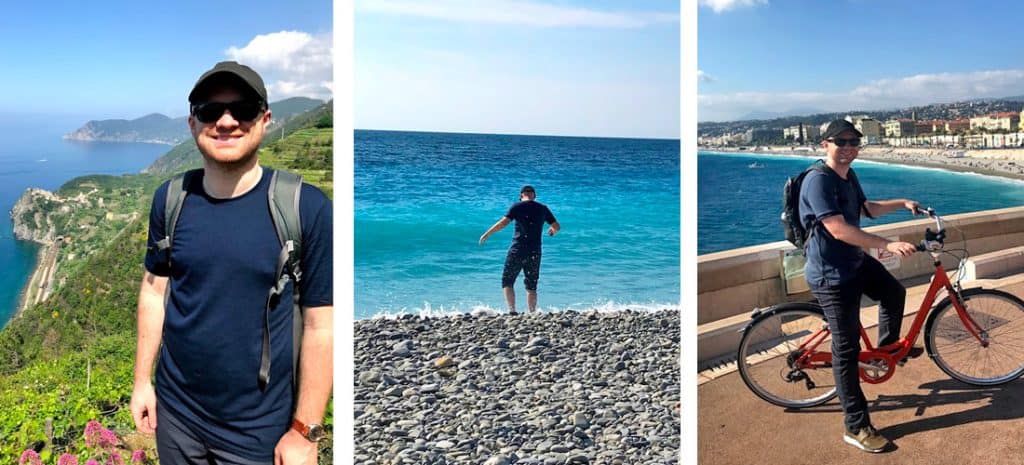
I normally travel with only two pairs of pants—usually a pair of dark jeans and a pair of neutral-colored pants.
Dark jeans can be dressed up or completely casual—plus, they match everything. You can wear jeans for months without washing them. Plus, jeans are a staple in every European’s wardrobe.
Some hardcore travelers don’t wear jeans because they are fairly heavy and take forever to dry. While they’re right, I still think jeans are perfectly fine for European travel.
Also, bring a pair of well-fitting neutral/dark color chinos (lightweight cotton). These look nice if you want to dress them up a bit.
I don’t think you need to shell out for expensive “travel” pants, but there are plenty of great options if that’s a route you want to take (they’re more of a luxury than a necessity).
Here are a few recommended travel pants:
- Bluffworks makes solid travel clothing that is both functional and fashionable. They have two main styles of travel pants—the Original ($98) and the Ascender Chinos ($125). Both pants are super tough, breathable, moisture-wicking, wrinkle-resistant, lightweight, and they have hidden security pockets.
- Bluffworks also has a pair of super comfortable Departure Travel Jeans that look nice. They’re also lightweight, stretchy, and have a hidden zippered security pocket.
- Western Rise is another company that makes travel-friendly pants that are durable yet stretchy and stain-resistant. The AT Slim Rivet Pant is their most popular and they retail for $129.
- Uniqlo has cheap pants made from high-tech fabrics. The quality isn’t great but they’re cheap.
Shorts
Traditionally, European adults didn’t wear shorts often but I don’t think that’s true these days—especially in Southern Europe. I recommend avoiding khaki cargo shorts and athletic shorts, as they are often associated with the stereotypical American tourist outfit, but a well-fitting pair won’t make you stand out.
Jackets and Rainwear
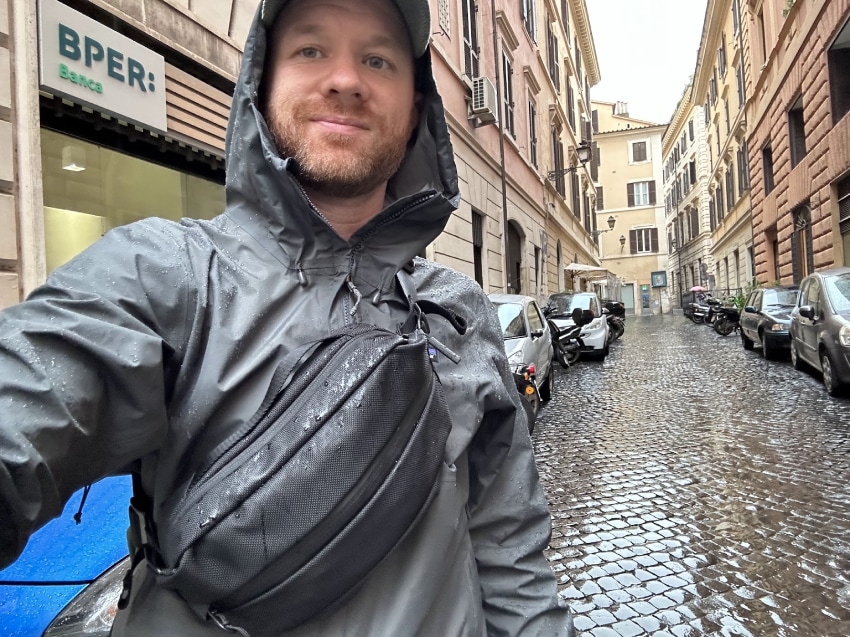
Obviously, whether you take a jacket or not will depend on when and where you travel.
- Fleece Jacket – A nice fleece jacket is great because has a great warmth-to-weight ratio. I suggest getting a black one because it will be the most versatile. Patagonia has a lot of amazing options.
- Rain Jacket: A rain jacket is nice to have. I recommend getting a lightweight jacket that can be easily packed away.
- The Patagonia Houdini weighs in at a crazy light 3.6oz and can be found online for $99. Available via REI and Amazon
- Outdoor Research Helium II is another lightweight rain jacket that only weighs around 6oz. It can be packed down the size of a baseball so it’s a nice summer jacket. It is a little pricy at $140-$170. Available via REI and Amazon.
- Helium HD Rain Jacket is quite similar to the popular Helium II but it is just a tad heavier at 9oz (which is still insanely light). Unlike other jackets, it has a few extra features like front pockets & pit zips. It sells for around $200. Available via Amazon.
- The Marmot PreCip Jacket is not the lightest jacket on our list (it still only weighs a respectable 11oz) but a bit more durable than others. Price: $100. Available via REI and Amazon.
- Lightweight Puffy Jacket: I love bringing a lightweight down jacket when I travel in cool weather. Down is ultralight but still provides a lot of warmth. It’s also a versatile item — it makes a nice outer layer on cool days and an excellent insulating mid-layer for cold days.
- The Patagonia Nano Puff (11.9 oz) provides a lot of warmth for a light jacket. It’s also more affordable at $199. Available via Amazon and REI.
- The Mountain Hardware “Ghost Whisper” jacket is only 7.2 oz. It is water-resistant, has pockets, and can often be found for under $180 — so it’s a bit more affordable than similar jackets. Available via Amazon and REI.
- Uniqlo sells synthetic down jackets for $60-$70. Don’t expect crazy features or ultra-lightweight, but it’s a good budget-friendly option.
Miscellaneous Items
- Sunglasses – Rayban sunglasses are a very classic choice.
- Scarf – Both men and women wear scarves in the summer and winter.
- Hat and Gloves
TRAVEL ACCESSORIES
Here are a few travel accessories you might want to bring along as you backpack through Europe.
Travel Backpack
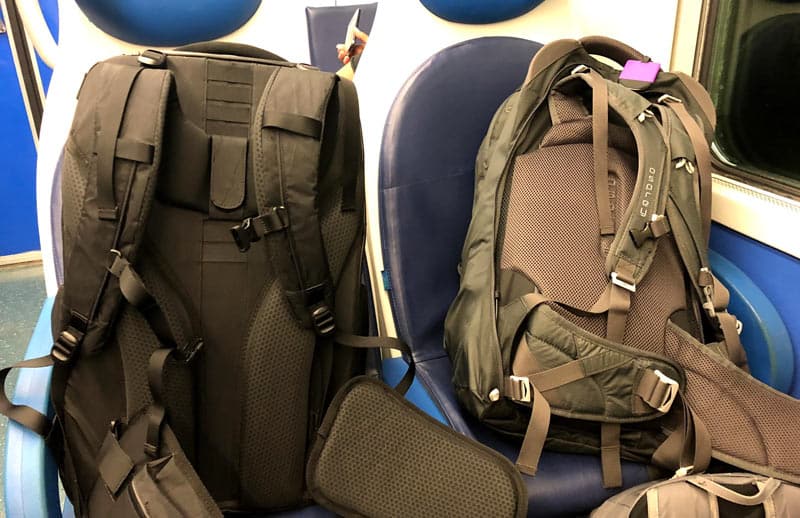
Every backpacker needs a quality backpack and I’ve written extensively about my favorite travel backpacks. Here are a few of my top picks:
- Aer Travel Pack 3 Review
- Osprey Farpoint 55 Review and Osprey Farpoint 40 Review
- Cotopaxi Allpa 42 Travel Backpack Review
Packing Cubes
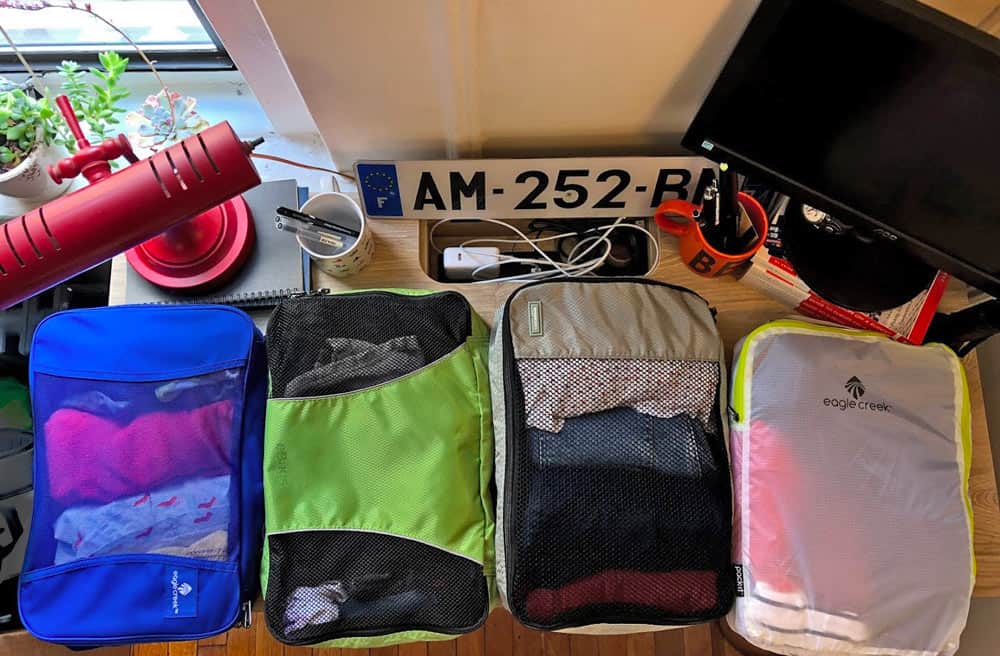
Get yourself some packing cubes because it makes backpack-living much easier. Packing cubes are small, lightweight bags used for packing your clothes into separate compartments. I separate items into different cubes — so I’ll put socks in one, underwear in another, shirts in another, etc.
These things make it easy to access all your clothes without having to rummage through everything. They also help reduce wrinkles and they help compress your clothing so you can fit more stuff into smaller luggage.
Here are a few Of my favorite packing cubes:
- Eagle Creek Pack-It Cubes
- Eagle Creek Spectre Tech Packing Cubes
- eBags Packing Cubes
- AmazonBasics Packing Cubes
Read a more in-depth review of our favorite packing cubes.
TRAVEL DAYPACK
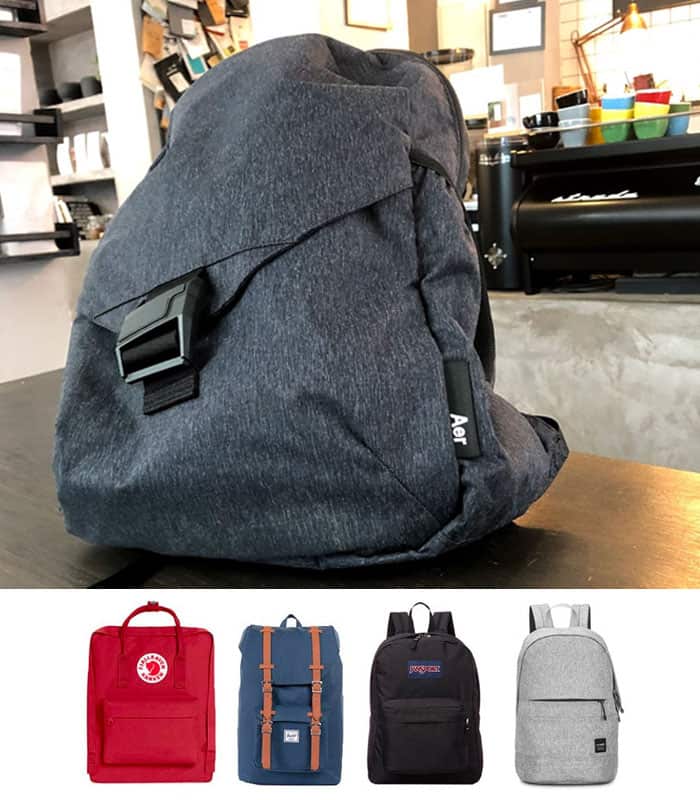
Bring a small backpack to haul around small items like your camera, rain jacket, etc., as you’re out for the day. Ideally, your daypack will easily pack into your main luggage during travel days. Here’s a list of my favorite daypacks to give you an idea of what to look for in a daypack.
eSIM DATA PLAN FOR FAST AND CHEAP MOBILE DATA
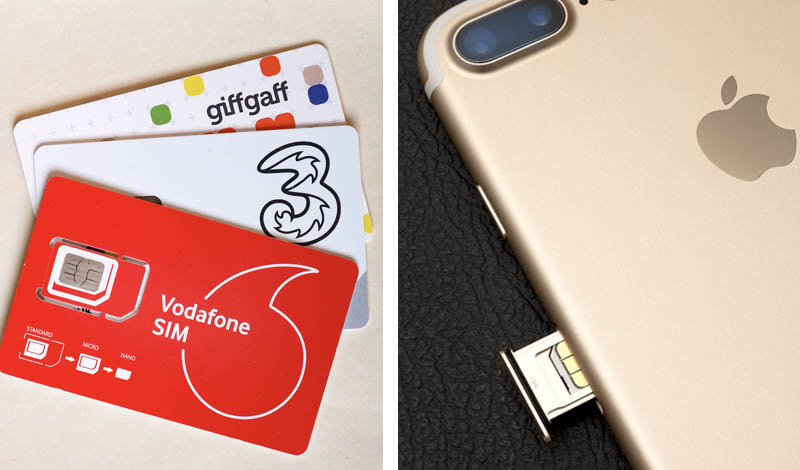
The cheapest way to get mobile data for your phone is by using a European eSIM or SIM card — this is much cheaper than using your home carrier’s International Mobile Data plan.
For example, an eSIM data plan will cost you about $3/day as opposed to $10-$15/day from your current carrier.
You can read about my guide to using smartphones and data plans in Europe but I recommend buying your eSIM/SIM card from SimOptions.com or an eSIM from Holafly.
TRAVEL TOWEL
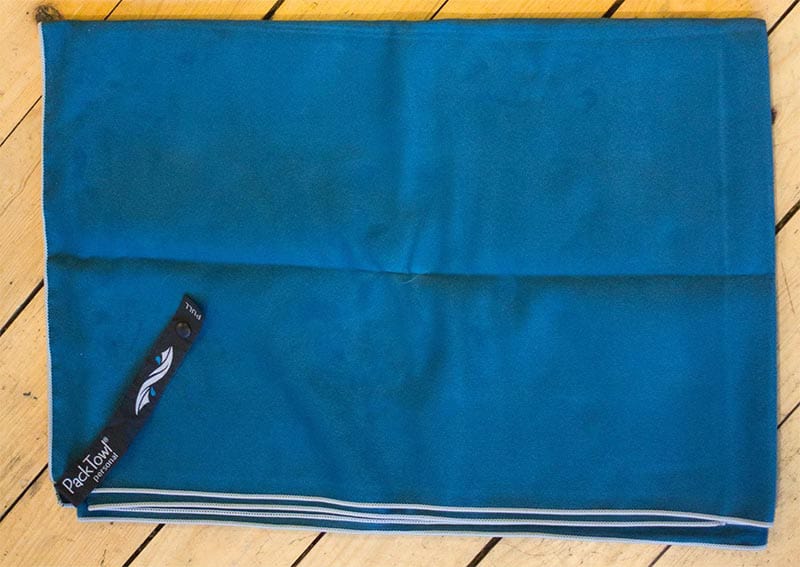
A quick-drying travel towel is a must because a normal towel takes hours to dry — which is no good when you’re always on the move (i.e. a wet towel shoved into a backpack will make everything smell musty). These travel towels soak up a lot of liquid but air dry in a few hours.
Here are two travel towels I like:
SMALL FLASHLIGHT

A small keychain flashlight comes in handy in hostels so you don’t wake up everyone when you need to find something in the dark. They are also nice for navigating dark streets, illuminating your luggage, etc.
My top pick is the Streamlight 73001 Nano Light Miniature Keychain LED Flashlight—this thing is tiny while still giving off lots of light. Honestly, anything from Streamlight is going to be a solid product so check out their page on Amazon.
NOTEBOOKS

Jot down phone numbers, directions, addresses, restaurants, spending, etc. in a Moleskine Notebook, Field Notes, or Rhodia notebook. It also makes a nice souvenir after the trip is over.
PADLOCK & RETRACTABLE CABLE LOCK

Keep your stuff safe when you’re staying in hostels. I like the Master Lock Set-Your-Own-Combination Padlock because it allows you to set your own combo.
Retractable cable locks are handy for securing your bag to your bunk or a luggage rack.
TRAVEL SLEEP SHEET
Consider bringing a sleep sheet/sleep sack if you’re worried about the cleanliness of your hostel sheets. The cheapest option is a cotton Sleep Sheet. Silk Sleep Sacks are more expensive but they’re lighter, less bulky, and feel great to sleep in.
EARPLUGS & EYE MASK
Sleeping on trains/planes/buses/hostels isn’t always easy so consider packing an eye mask. Earplugs are nice too (especially if there is someone who snores in your room). These Mack’s Pillow Soft Silicone Earplugs are comfortable for sleeping.
WATER BOTTLE

A basic water bottle works but flexible water bottles like the Platypus Soft Bottle can be rolled up when empty.
TRAVEL UTENSILS

A set of Plastic Travel Utensils is super handy for picnics since most grocery stores don’t provide utensils. I thought this titanium spork was kind of funny.
TOOTHBRUSH COVER

Steripod Clip-on Toothbrush Sanitizer cover works well to keep your brush sanitized by using some voodoo science. Or you can just get a normal toothbrush cover if that’s how you roll.
DIGITAL LUGGAGE SCALE
A digital luggage scale is great for avoiding those costly overweight luggage fees.
PHOTOCOPIES OF IMPORTANT DOCUMENTS
Make copies (physical and electronic) of your passport and other important documents. I email them to myself or save them to Google Docs.
ZIPLOC BAGS (MULTIPLE SIZES)
Separate your dirty/wet clothes with Plastic bags. It’s a good idea to put our liquids in a sealable bag in case of a leak. The large 3-gallon bags are nice for keeping your dirty shoes away from your clothes.
MONEY BELT
One of the best ways to avoid becoming a pickpocketing victim is to wear a money belt (learn more about avoiding pickpockets). I don’t wear one but a lot of people do.
COLLAPSIBLE UMBRELLA
A travel umbrella is good in case of rain.
LAUNDRY STUFF

- Sink Stopper: Pack a simple Travel Sink Stopper if you plan on washing clothes in the sink.
- Travel Laundry Soap: Bring some Woolite Travel Laundry Soap or Travelon Laundry Soap Sheets if you plan on doing laundry while traveling.
- Flexible Travel Clothesline: A rubber braided clothesline is a nice way to air dry anything you need to wash. Additionally, the braided clotheslines are ideal because they don’t require any clothespins — just stick the clothes through the braids.
- Stain Remover: Tide To Go Stain Remover Pens and individually wrapped Shout Wipes work really well on stains and take up no space in your bag.
LINT ROLLER
Keep your clothes lint-free with a lint roller and stop looking like a slob.
GUIDEBOOKS
Research the cities you’re going to visit so check out a few guidebooks. Our favorite publishers are:
A small phrasebook is nice if you want to learn a bit of the local language.
ELECTRONICS PACKING LIST
Technology has changed how we travel so here are a few gadgets to help fuel your addiction to technology.
Quick Note: Europe and North America use different voltages so some American electronics won’t work in Europe. But don’t worry because high-end electronics like laptops, phones, cameras, etc. will all work fine with a plug adapter (see below). I suggest reading our guide to traveling with electronics for more in-depth advice about using electronic devices while traveling.
OUTLET PLUG ADAPTERS

Pack a few outlet plug adapters. Continental Europe uses the same plug except for the UK — technically, Italy and Switzerland use a slightly different plug but the two-prong plugs (like seen above) still work. If you want to be safe you can buy specific adapters for those countries.
This simple set of adapters from Ceptics will work fine but you might want a plug adapter with USB plugs since most electronics charge via USB these days.
TRAVEL POWER STRIP

I’ve stayed at many hostels/hotels that very few power outlets, so a power strip is a worthwhile investment. The Belkin Travel Power Strip with USB ports is a popular option since it has USB ports but there are plenty of other travel power strips.
PORTABLE PHONE CHARGER
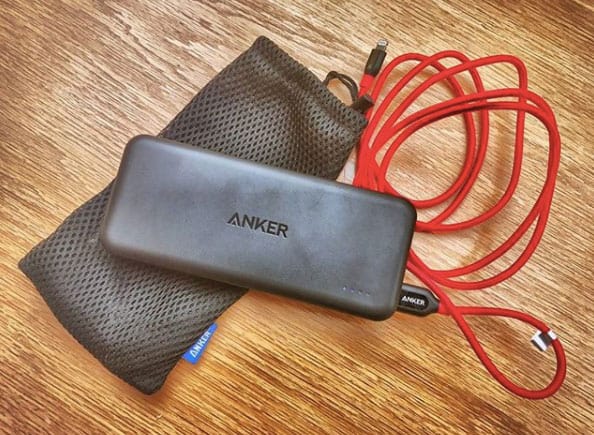
Google Maps and Instagram will kill your phone battery so pack a portable battery. I use Anker PowerCore 10000 because it’s tiny and affordable.
TABLET OR LAPTOP
I hate traveling with a laptop but I’m a big fan of traveling with my iPad.
E-READERS
Having a book to read on those long flights and train rides is great but lugging a heavy book around is a pain. The Amazon Kindle is great for those of you who love to read. You can even download a lot of travel guidebooks.
HEADPHONES
I really love traveling with my wireless Apple AirPods—check Amazon since they’re often cheaper on sale there. I also travel with a cheap pair of in-ear, wired headphones for airplanes.
TRAVEL TOILETRIES

Try minimizing the number of toiletries you bring because liquids add a ton of weight. Don’t forget that you can buy pretty much anything once you’re in Europe. Here is a general list of things you might want:
- Shampoo/Conditioner/Body Wash: I pour shampoo and body wash into these leak-proof GoToob travel-sized bottles. If I need more then I’ll buy it in Europe.
- Toothpaste & Toothbrush: Don’t waste your money on a travel toothbrush — just bring a normal toothbrush and a toothbrush cover.
- Shaving Stuff (Razors & Cream): You can find pretty much the exact same products abroad but razors do seem to be a lot more expensive in Europe.
- Deodorant: Deodorant that I buy in Europe never seems to work as well so bring your own.
- Chapstick w/Sunscreen
- Contact Lenses/Solution/Glasses: Contact solution is actually a pain to buy because it’s normally only sold in pharmacies. Plus it isn’t cheap. I’d recommend bringing your own if you can.
- Condoms: Some souvenirs are no fun… so it’s better safe than sorry. I’d buy them before you go. Amazon has got you covered.
- Travel Fabric Freshener: Your clothes will probably smell a bit funky after a while so travel-sized Febreze To Go is a good way to stay a little fresher.
- Travel Toilet Paper: Play it safe and pack some travel toilet paper in your daypack.
- Wet Wipes/Baby Wipes: These are a lifesaver when you actually need them. Cottonelle Fresh Flushable Wipes are individually wrapped.
- Hand Sanitizer: You’ll be touching so much dirty stuff all day, and you don’t want to get sick as you’re traveling.
- Body Powder: Stop chafing caused by all that walking — especially if it is really hot. Anti Monkey Butt is our favorite.
- Foot Cream: Pamper your feet with O’Keeffe’s Healthy Feet Cream.
- Pepto Tablets: Be sure to pack some Pepto-Bismol tablets for all that questionable street food.
- Band-Aids: Heal/prevent those blisters with Band-Aids for feet.
- Pain Medicine: Over-the-counter pain medicine (even basic stuff like Tylenol) is only from a pharmacy in Europe. This isn’t a big problem but it’s nice to have a few pills on hand.
- Prescription Drugs: Ensure you have the original bottle/box in case you’re asked to prove the medicine is yours. Make sure you have enough medicine to cover your entire trip since it might be hard to get any refills.
TRAVEL INSURANCE
Travel insurance can be a great investment if you run into any trouble on the road because it helps cover your travel gear, flights, accommodation, rail passes, medical emergencies, and more. I use World Nomads but here is a guide to buying travel insurance if you want to know what to look for when buying travel insurance.
Stuff You Don’t Need
There are a lot of things geared toward travelers that you probably won’t need if you’re traveling through Europe.
- Sleeping Bag: Sleeping bags aren’t needed unless you are camping or sleeping on someone’s floor.
- Sleeping Pad: Again, unless you’re camping or sleeping on the ground, you won’t need a sleeping pad.
- Water Filter: Europe has clean water so no need for a portable filter.
- Books: Books are bulky and heavy. Many hostels have a collection of books, and you’re normally free to swap. Travelers also swap books with each other.
- Beach Towel: Normal cotton towels take forever to dry and take up a lot of room. If you do bring one, make sure it is dry before you put it in your backpack because a damp towel will make everything in your bag smell really musty. I recommend a quick-drying travel towel.
- Hiking/Backpacking Food: There is no need for prepackaged travel meals. However, I throw in a couple of RX or Cliff bars just in case I get hungry while on the go.
WHERE TO BUY TRAVEL GEAR
There are so many places to buy all your travel gear so I wanted to put together a list of places to check out.
- Amazon seems to have just about everything and the prices tend to be pretty good.
- Zappos has much more than just shoes — they also sell a pretty good selection of travel gear like clothes, jackets, socks, and backpacks. Their prices are sometimes a bit higher than other stores but their free super-fast shipping and dead-simple returns are often worth the extra cost.
- REI is one of the largest outdoor retailers and they have a ton of travel gear. A lot of their stuff is more “outdoorsy” but they’re good for things like backpacks, socks, underwear, etc.
- Bluffworks sells travel clothing that actually looks like normal, fashionable clothes.
- Uniqlo is the king of cheap but fairly decent high-tech travel clothing.
More Packing Tips For Europe

Here are some more helpful packing articles that I’ve written:
- The Best Travel Shoes
- The Best Travel Backpacks
- The Best Travel Pants For Men
- Winter Packing List for Europe
- Best Waterproof Boots for Men
- Guide To Using Smartphones, SIM Cards, and Data Plans In Europe - August 2, 2025
- Backpacking Europe Packing List — My Europe Travel Packing Guide - July 26, 2025
- The Best Travel Backpacks | In-Depth Buyer’s Guide & Backpack Reviews - July 5, 2025

No Funny Business
The Savvy Backpacker is reader-supported. That means when you buy products/services through links on the site, I may earn an affiliate commission—it doesn’t cost you anything extra and it helps support the site.
Thanks For Reading! — James
Questions? Learn more about our Strict Advertising Policy and How To Support Us.





